Chapter 6: Operations with fractions
6.1 Addition and subtraction of fractions
In Chapter 4, you learnt that a common fraction is written as two whole numbers, one on top of the other: numeratordenominator.
- The denominator represents all the parts of a whole. For example, in the fraction 27, each whole is divided into 7 parts.
- The numerator represents only the parts of a whole we are dealing with. For example, in the fraction 27, we are dealing with only 2 out of 7 parts.
Adding fractions with the same denominator
Usman and Adamu are at a birthday party. There is a cake that is cut into 4 pieces:

Suppose Usman gets 14 of the cake:

Suppose Adamu also gets 14 of the cake:

If they put their pieces of cake together, they have 24 of the cake:

We write this as:
14+14=24Remember that the denominator of a fraction tells us into how many parts a whole is divided. In this case, one whole cake is divided into 4 pieces. Together, the boys have 2 of those pieces.
In Chapter 4, you learnt how to write a fraction in its simplest form. This is when the numerator and denominator have no common factor.
The simplest form of 24 is 12.

We may therefore write:
14+14=12Subtracting fractions with the same denominator
Suppose another cake arrives at the birthday party that Usman and Adamu are attending. This cake is also cut into 4 pieces. Someone immediately takes a piece, so that only 3 of the 4 pieces are left. The cake may now be represented as follows.
There is 34 of the cake left:

Danladi did not have any cake yet. He gets 1 piece, which is 14 of the cake:

After Danladi took his piece, 24 of the cake is left:

We write this as:
34−14=24The simplest form of 24 is 12.

We may therefore write:
34−14=12Worked example 6.1: Adding fractions with the same denominator
Calculate:
710+110
-
Method 1 (Using diagrams)
1. The denominator shows into how many parts one whole must be divided. Represent this in a diagram. In this case, there must be 10 parts.

2. Shade the number of parts shown by the first numerator. The first numerator is 7.
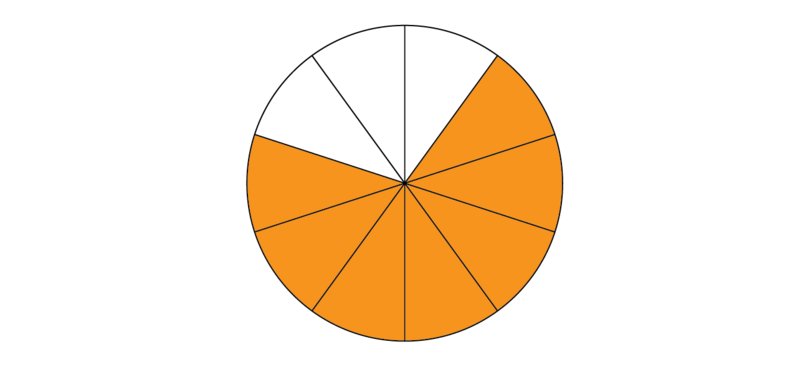
3. Now also shade the number of parts shown by the second numerator. The second numerator is 1. We must shade another 1 part.
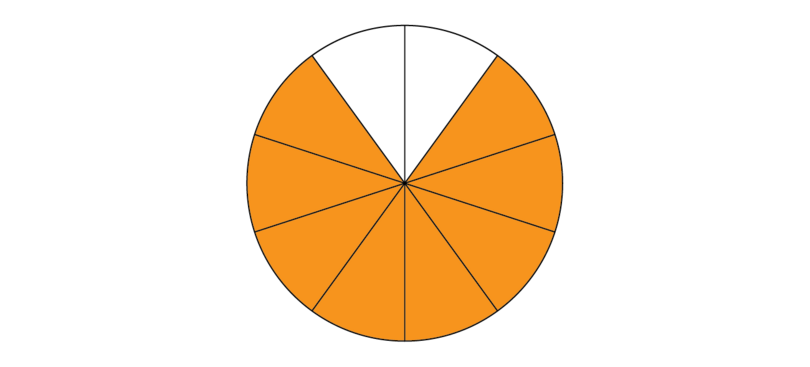
4. Write the total shaded part as a fraction:
8105. Write the fraction in its simplest form.
8÷210÷2=456. The full calculation is:
00710+110=810=45 -
Method 2 (Calculating directly)
1. The denominator shows into how many parts one whole must be divided. Write down the denominator.
00710+110=00000102. Write down the numerators that must be added.
00710+110=7+1103. Add the numerators.
00710+110=7+110=8104. Simplify the answer.
00710+110=7+110=810=45
Worked example 6.2: Subtracting fractions with the same denominator
Calculate:
79−39
-
Method 1: Using diagrams
1. The denominator shows into how many parts one whole must be divided. Represent this in a diagram. In this case, there must be 9 parts.

2. Shade the number of parts shown by the first numerator. The first numerator is 7.
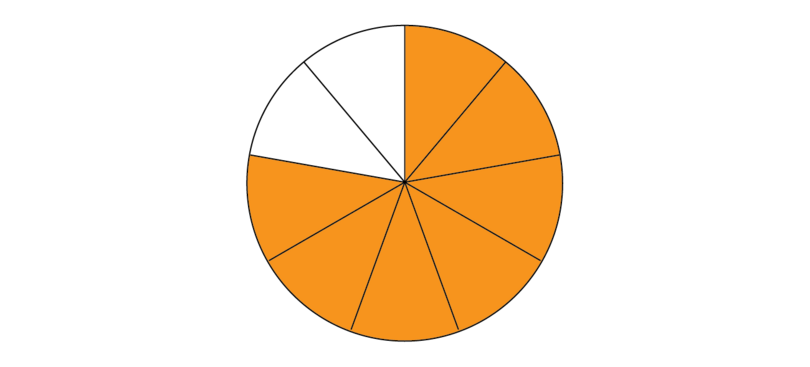
3. Scratch out the number of parts shown by the numerator that is subtracted. The second numerator is 3. We must scratch out 3 parts.
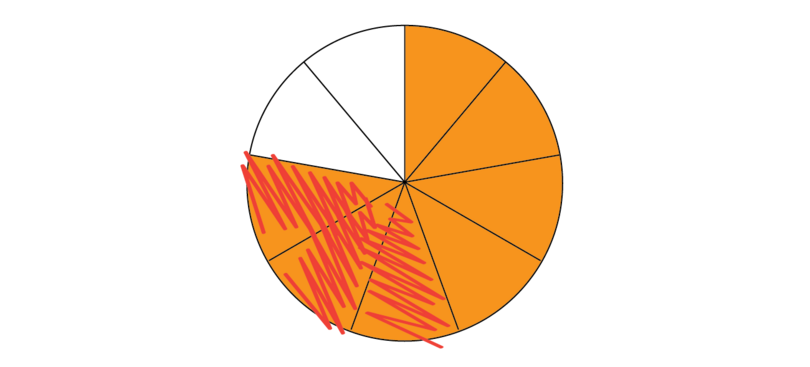
4. Redraw the diagram, shading only the parts that are left over. There are 4 parts left over.

5. Write the shaded part as a fraction.
496. Check whether the fraction is in its simplest form.
In this case, the numerator and denominator have no common factors.
7. The full calculation is:
0079−39=49 -
Method 2: Calculating directly
1. The denominator shows into how many parts one whole must be divided. Write down the denominator.
0079−39=000092. Write down the numerators that must be subtracted.
0079−39=7−393. Subtract the numerators.
0079−39=7−39=494. Simplify the answer if necessary. In this case, is it not necessary.
Exercise 6.1: Add and subtract fractions that have the same denominators
Calculate each of the following.
-
311+511
00311+511=3+511=811
-
712+312
00712+312=7+312=1012=56
-
1136+1336
001136+1336=11+1336=2436=23
-
1517−917
001517−917=15−917=617
-
1920−720
001920−720=19−720=1220=35
-
4148−548
004148−548=41−548=3648=34
Adding and subtracting fractions with different denominators
Suppose we want to determine the following:
- 23+12
- 23−12
23 of a cake may be represented as:

12 of a cake may be represented as:

We can divide one cake into either 2 pieces or 3 pieces. We cannot divide the cake into both. To overcome this problem, we have to express both fractions with the same denominator. The lowest common denominator (LCD) of 2 and 3 is 6. The equivalent fractions of 23 and 12, with 6 as their denominator, are:
23=2×23×2=46 12=1×32×3=36Now we can follow the same method as before.
If necessary, go back to Chapter 4 for information about the lowest common denominator (LCD) of two or more fractions. Revise how find equivalent fractions that all have the LCD as their denominator.
Worked example 6.3: Adding fractions with different denominators
Calculate:
23+12
-
Step 1: Compare the denominators. If they are different, find the LCD.
The LCD of 2 and 3 is 6.
-
Step 2: Find equivalent fractions with the LCD as their denominators.
23=46 12=36 -
Step 3: Use the LCD to represent the parts of one whole in a diagram.
In this case, there must be 6 parts.

-
Step 4: Shade the number of parts shown by the first numerator of the equivalent fraction.
This is 4.
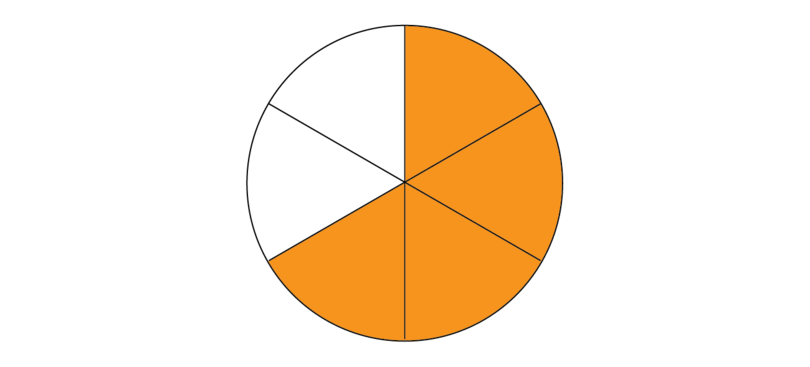
-
Step 5: Shade the additional parts shown by the second numerator of the equivalent fraction.
The second numerator is 3. We must shade another 3 parts.
There are only 2 "gaps" in the shape that can be shaded. Therefore, we need to add another shape.
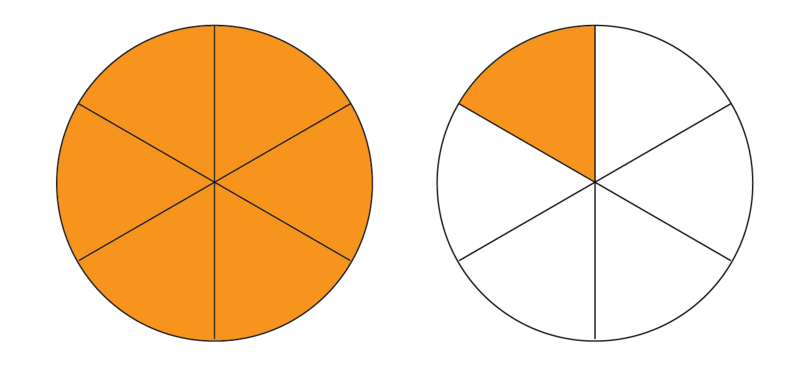
-
Step 6: Write the total shaded part as a fraction.
The fraction is 76.
Remember, the denominator shows into how many parts one whole is divided. The numerator shows the total number of those parts that we are dealing with.
-
Step 7: Write the answer in its simplest form or as a mixed number.
76=116 -
Step 8: Write out the whole calculation.
0023+12=46+36=4+36=76=116
Worked example 6.4: Subtracting fractions with different denominators
Calculate:
23−12
-
Step 1: Compare the denominators. If they are different, find the LCD.
The LCD of 2 and 3 is 6.
-
Step 2: Find equivalent fractions with the LCD as their denominators.
23=46 12=36 -
Step 3: Use the LCD to represent the parts of one whole in a diagram.
In this case, there must be 6 parts.

-
Step 4: Shade the number of parts shown by the first numerator of the equivalent fraction.
This is 4.

-
Step 5: Scratch out the number of parts shown by the numerator of the equivalent fraction that is subtracted. Then redraw the diagram with only the parts that are left over shaded.
The second numerator is 3. We must scratch out 3 parts.

There is only one part left over.

-
Step 6: Write the shaded part as a fraction.
16 -
Step 7: Check whether the fraction is in its simplest form.
In this case, the numerator and denominator have no common factors.
-
Step 8: Write out the whole calculation.
0023−12=46−36=4−36=16
As you get used to adding and subtracting fractions, it will no longer be necessary to draw diagrams. Just be sure to always write out the calculation in full.
Exercise 6.2: Add and subtract fractions that have different denominators
Calculate each of the following.
-
34+18
LCD = 8
0034+58=68+18=6+18=78 -
23+27
LCD = 21
0023+27=1421+621=14+621=2021 -
1130+412
30=2×3×5
001130+412=2260+2060=22+2060=4260=710
12=22×3
LCD=22×3×5=60 -
1015+820
15=3×5
001015+820=4060+2460=40+2460=6460=1615=1115
20=22×5
LCD=22×3×5=60 -
18+56+510
8=23
0018+56+510=15120+100120+60120=15+100+60120=175120=3524=11124
6=2×3
10=2×5
LCD=23×3×5=120 -
1115−35
LCD = 15
001115−35=1115−915=11−915=215 -
56−25
LCD = 30
0056−25=2530−1230=25−1230=1330 -
912−315
12=22×3
00912−315=4560−1260=45−1260=3360=1120
15=3×5
LCD=22×3×5=60 -
2324−1218
24=23×3
002324−1218=6972−4872=69−4872=2172=724
18=2×32
LCD=23×32=72 -
910−16−215
10=2×5
00910−16−215=2730−530−430=27−5−430=1830=35
6=2×3
15=3×5
LCD=2×3×5=30
Adding and subtracting mixed numbers
Remember that a mixed number is made up of a whole number and a proper fraction. There are various methods that may be used to add and subtract mixed numbers. It is recommended that you first convert all mixed numbers to improper fractions before you add or subtract.
If necessary, go back to Chapter 4 and revise how to convert mixed numbers to improper fractions.
Worked example 6.5: Adding mixed numbers
Calculate:
245+123
-
Step 1: Convert the mixed numbers to improper fractions.
245=(2×5)+45=145 123=(1×3)+23=53 -
Step 2: If the denominators differ, find equivalent fractions with the LCD as their denominators.
The LCD of 3 and 5 is 15.
145=4215 53=2515 -
Step 3: Write down the LCD and add the numerators of the equivalent fractions.
004215+2515=42+2515=6715 -
Step 4: Simplify the answer by converting the improper fraction to a mixed number.
004215+2515=42+2515=6715=4715
Exercise 6.3: Add and subtract mixed numbers
Calculate each of the following.
-
216+138
216=136 138=118
6=2×3
00136+118=5224+3324=52+3324=8524=31324
8=23
LCD=23×3=24 -
2512−1328
2512=2912 1328=3128
12=22×3
002912−3128=20384+9384=203−9384=11084=5542=11342
28=22×7
LCD=22×3×7=84 -
178+2310−3120
178=158 2310=2310 3120=6120
8=23
00158+2310−6120=7540+9240−12240=75+92−12240=4540=98=118
10=2×5
20=22×5
LCD=23×5=40
6.2 Multiplication and division of fractions
Multiplication: whole number x fraction
You might remember from previous years that multiplication is a form of addition. For example, 5×△ means △+△+△+△+△.
In the same way, 5×14 means 14+14+14+14+14.
Worked example 6.6: Multiplying: whole number x fraction
Calculate:
5×14
-
Step 1: Write the multiplication as an addition.
5×14=14+14+14+14+14 -
Step 2: The denominator shows into how many parts one whole must be divided. Represent this in a diagram.
In this case, there must be 4 parts.

-
Step 3: Shade the number of parts shown by the first numerator.
This is 1.

-
Step 4: Shade the number of parts shown by the rest of the numerators.
We must shade another 1+1+1+1 parts.
There are only 3 "gaps" in the shape that can be shaded. Therefore, we need to add another shape.
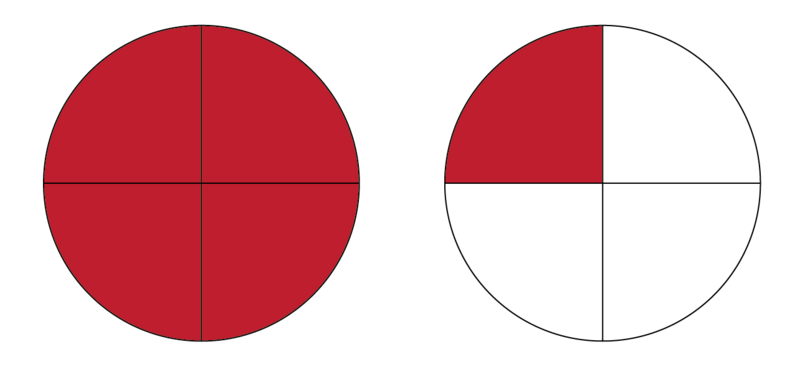
-
Step 6: Write the total shaded part as a fraction.
The fraction is 54.
Remember, the denominator shows into how many parts one whole is divided. The numerator shows the total number of those parts that we are dealing with.
-
Step 7: Write the answer in its simplest form or as a mixed number.
54=114 -
Step 8: Write out the whole calculation.
0014+14+14+14+14=1+1+1+1+14=54=114Note the numerator: 1+1+1+1+1=5×1
Multiplication: fraction x whole number
By now you know that 25 of a cake may be represented as follows:

Suppose Azubuike ate 25 of 3 cakes. How much cake did he actually eat? We must multiply 25 by 3 cakes: 25×3.
Worked example 6.7: Multiplying: fraction x whole number
Calculate:
25×3
-
Step 1: Use a diagram to represent the fraction.
The fraction is 25.

-
Step 2: Add diagrams as required by the whole number.
The whole number is 3. This means we have 25+25+25.
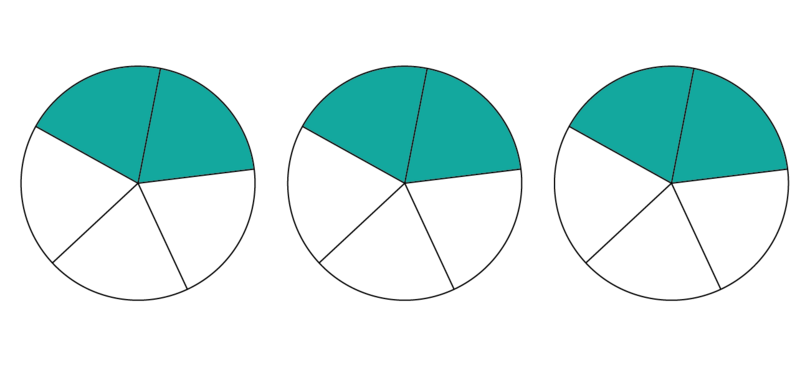
-
Step 3: Put all the shaded parts together into one shape as far as possible, and then start using the next shape you need.
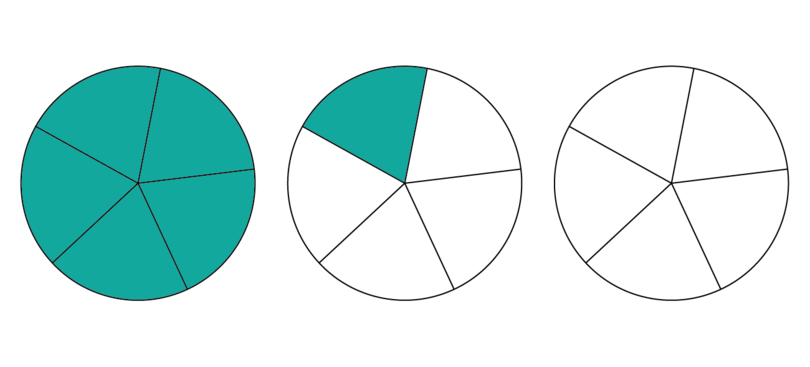
-
Step 4: Write the total shaded part as a fraction.
The fraction is 65.
Remember, the denominator shows into how many parts one whole is divided. The numerator shows the total number of those parts that we are dealing with.
-
Step 5: Write the answer in its simplest form or as a mixed number.
65=115 -
Step 8: Write out the whole calculation.
0025+25+25=2+2+25=65=115Note the numerator: 2+2+2=3×2
Exercise 6.4: Multiply fractions and whole numbers
Calculate each of the following.
-
4×69
004×69=69+69+69+69=6+6+6+69=249=83=223
-
6×310
006×310=310+310+310+310+310+310=3+3+3+3+3+310=1810=95=145
-
38×5
0038×5=38+38+38+38+38=3+3+3+3+38=158=178
-
914×4
00914×4=914+914+914+914=9+9+9+914=3614=187=247
Once you understand how to multiply whole numbers and fractions, you may use this short method.
Example: 27×6
Denominator (stays the same): 007
Numerator: 2×6=12
Calculation:
0027×6=2×67=127=157
Multiplication: fraction x fraction
When we write 23×34, it means two thirds, 23, of three quarters, 34.
By now you know that 34 of a cake may be represented as follows:
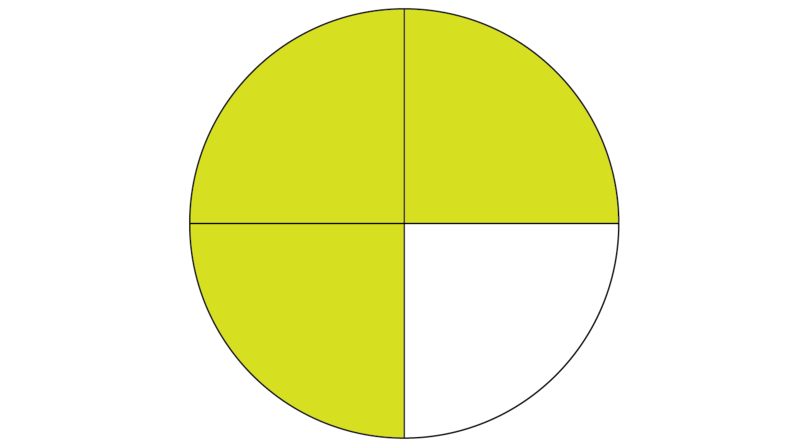
Now we want to know how much 23 of the shaded part is.
Worked example 6.8: Multiplying using a diagram: fraction x fraction
Calculate:
23×34
-
Step 1: Use a diagram to represent one of the fractions.

-
Step 2: Divide the shape further, according to the denominator of the other fraction.
The denominator of 23 is 3. This means we must divide each part of the shape further into 3 parts.
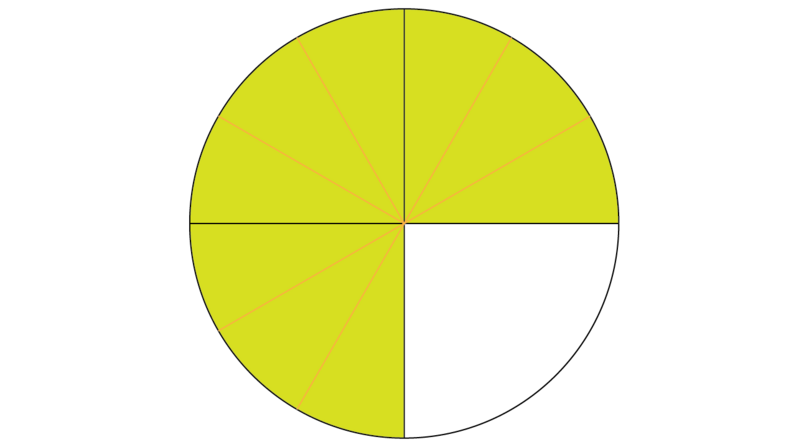
-
Step 3: Use another colour to shade the correct portion of the shaded part, according to the numerator of the fraction used in Step 2.
The numerator of 23 is 2. This means that we are interested in 2 of every 3 parts. Remember that we only want 23 of the part that is already shaded, 34.
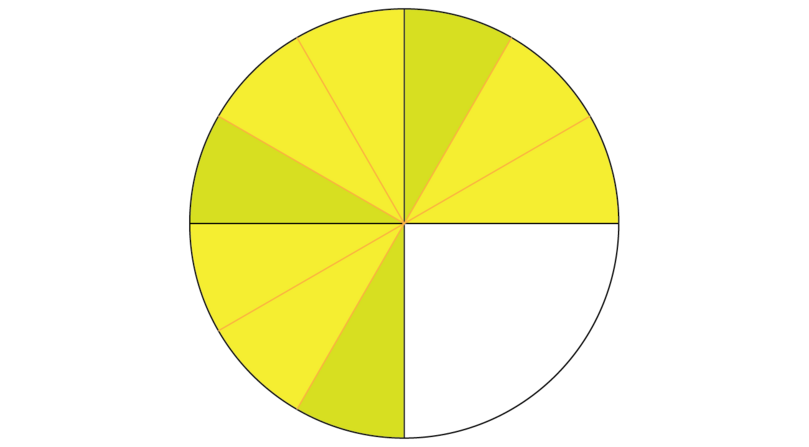
-
Step 4: Write the newly shaded part as a fraction of the whole shape.
Remember, the shape is now divided into 12 parts. The new shading covers 6 of those parts.
The fraction is 612.
-
Step 5: Write the answer in its simplest form or as a mixed number.
612=12 -
Step 6: Write out the whole calculation.
0023×34=612=12If you use the same method to determine 34×23, you will get the same answer.
See whether you notice a pattern when we write the first two lines of the calculation in Step 6 of the previous worked example as follows:
23×34=612When we multiply two fractions, we may follow this method:
numerator 1denominator 1×numerator 2denominator 2=numerator 1×numerator 2denominator 1×denominator 2Worked example 6.9: Calculating fraction x fraction directly
Calculate:
56×38
-
Step 1: Multiply the two numerators and multiply the two denominators.
56×38=5×36×8 -
Step 2: Find the numerator and denominator of the answer.
56×38=5×36×8=1548 -
Step 3: Write the answer in its simplest form or as a mixed number.
56×38=5×36×8=1548=516
Exercise 6.5: Multiply fractions with fractions
-
Use a diagram to determine 12×25.
Show 25 with a diagram:

Look at 12: The denominator 2 means each part must be further divided into 2:
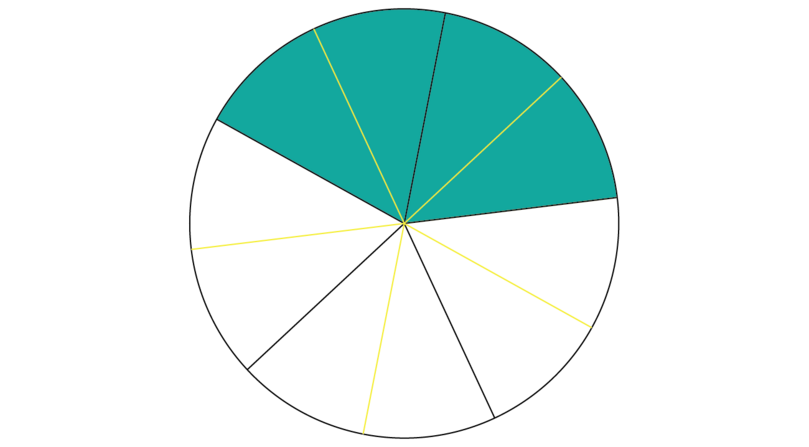
The numerator 1 means that we want 1 out of every 2 parts of the shaded area:
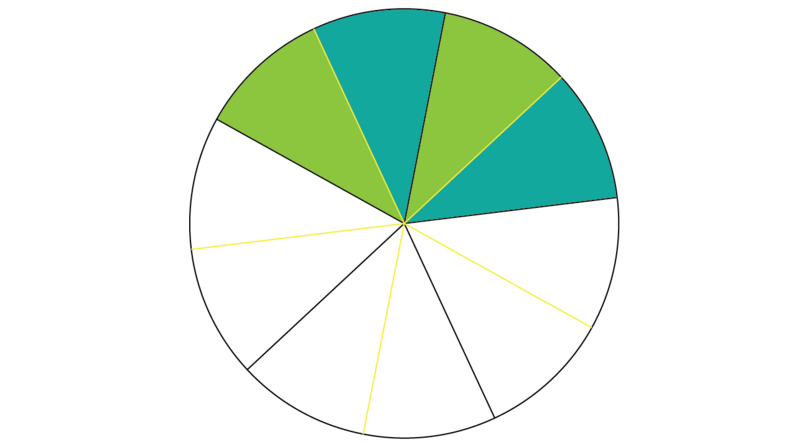
The new shading represents 210.
12×25=210=15 -
Calculate each of the following directly.
-
49×35
49×35=4×39×5=1245=415
-
67×910
67×910=6×97×10=5470=2735
-
1112×45
1112×45=11×412×5=4460=1115
-
49×35
Division: whole number ÷ fraction
Suppose there are 4 cakes available for Oluchi's birthday party. The cakes are quite small, so she wants each person to have 23 of a cake. How will Oluchi know how many people will get cake?
Oluchi must calculate 4÷23. Because she wants each person to get two thirds, 23, she must start by cutting each cake into 3 pieces.

Now she must work out how many people can each get 23 of a cake.
Worked example 6.10: Dividing using diagrams: whole number ÷ fraction
Calculate:
4÷23
-
Step 1: Represent all the parts of the whole number, according to the denominator of the fraction.
The denominator of the fraction is 3. We must divide 4 shapes into 3 parts each.

-
Step 2: Determine how many times the numerator of the fraction can be counted.
The numerator is 2. This means every 2 parts represents one count.

-
Step 3: Write down the answer.
There are 6 different colours. We can count every 23 six times. This means at Oluchi's birthday party, 6 people can each get 23 of a cake.
4÷23=6
Reciprocals of fractions
Division may be seen as another form of multiplication. Dividing by a fraction is the same as multiplying by the "opposite" of the fraction. The "opposite" of a fraction is called its reciprocal. The reciprocal is the fraction we get when we swap the numerator and the denominator. For example, the reciprocal of 27 is 72 and the reciprocal of 83 is 38.
reciprocal The "opposite" of a fraction, which we get by swapping the numerator and denominator.
Whole numbers also have reciprocals. We may write any whole number as an improper fraction with the denominator 1. For example, 5=51 and 13=131. Now we get the reciprocal by swapping the numerator and denominator. The reciprocal of 5 is 15 and the reciprocal of 13 is 113.
The reciprocal of a fraction is also called its multiplicative inverse. When you multiply a fraction and its multiplicative inverse, the answer is 1.
We may use reciprocals in division that involves fractions.
Worked example 6.11: Using a reciprocal to divide: whole number ÷ fraction
Calculate:
4÷23
-
Step 1: Regard division as another form of multiplication.
Dividing by a fraction is the same as multiplying by the reciprocal of the fraction.
4÷23=4×32 -
Step 2: Follow the short method for multiplying whole numbers and fractions.
Denominator: 002
Numerator: 4×3=12
Calculation:
004×32=4×32=122=6
Exercise 6.6: Divide whole numbers by fractions
Calculate each of the following.
-
2÷16
Multiply by the reciprocal of the fraction.
002×61=2×61=121=12 -
7÷45
Multiply by the reciprocal of the fraction.
007×54=7×54=354=834 -
8÷34
Multiply by the reciprocal of the fraction.
008×43=8×43=323=1023
Division: fraction ÷ whole number
At Ifetayo's birthday party, there is only 34 of one cake left. Ifetayo wants to share this equally between her two best friends, so that they can take it home.
The cake that is left may be represented as follows:

Now Ifetayo must figure out how she is going to share this equally between her two friends.
Worked example 6.12: Dividing using a diagram: fraction ÷ whole number
Calculate:
34÷2
-
Step 1: Use a diagram to represent the fraction.

-
Step 2: Divide the shape further, according to the whole number.
The whole number is 2. If we want to share the shaded portion between 2 people, we must divide each shaded part into 2 parts.
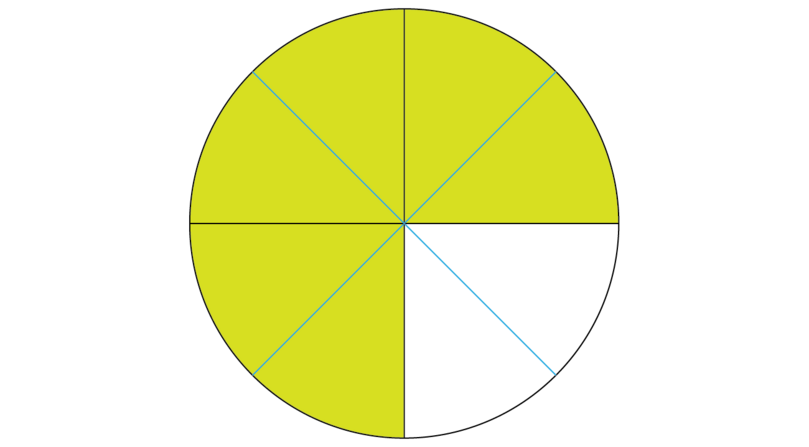
-
Step 3: Share the shaded parts equally, according to the whole number.
The whole number is 2. If we want to share the shaded parts equally between 2 people, we simply allocate them to person 1 and person 2.
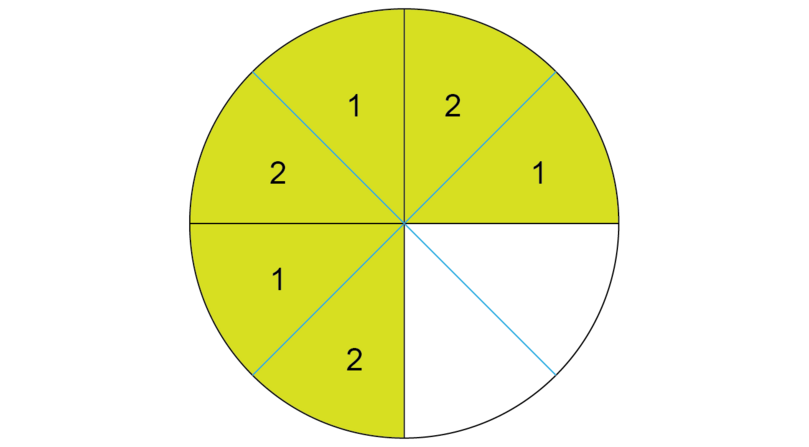
-
Step 4: Write down the fraction that each person gets.
If we divide 34 between two people, each person gets 38.
-
Step 5: Write down the answer.
34÷2=38
Worked example 6.13: Using a reciprocal to divide: fraction ÷ whole number
Calculate:
34÷2
-
Step 1: Regard division as another form of multiplication.
Dividing by a whole number is the same as multiplying by the reciprocal of the whole number.
34×12 -
Step 2: Follow the short method for multiplying fractions with fractions.
34×12=3×14×2=38
Exercise 6.7: Divide fractions by whole numbers
Calculate each of the following.
-
45÷6
Multiply by the reciprocal of the whole number.
45×16=4×15×6=430=215 -
615÷4
Multiply by the reciprocal of the whole number.
615×14=6×115×4=660=110 -
89÷10
Multiply by the reciprocal of the whole number.
89×110=8×19×10=890=445
Division: fraction ÷ fraction
Remember that there was only 34 of one cake left at Ifetayo's birthday party. Suppose, instead of dividing this between her two best friends, she rather decides to give 18 of the cake to as many people as possible.
We already know the cake that is left may be represented as follows:

Now Ifetayo must figure out how many people can get 18 of the cake to take home. She must calculate 34÷18.
Worked example 6.14: Using a diagram to divide: fraction ÷ fraction
Calculate:
34÷18
-
Step 1: Use a diagram to represent the first fraction.

-
Step 2: Divide the shape further, until the parts are equal to the denominator of the second fraction.
The denominator of the second fraction is 8.

-
Step 3: Determine how many times the numerator of the second fraction can be counted from the shaded parts.
The numerator of the second fraction is 1. This means every part represents one count. Remember that we can only count shaded parts.
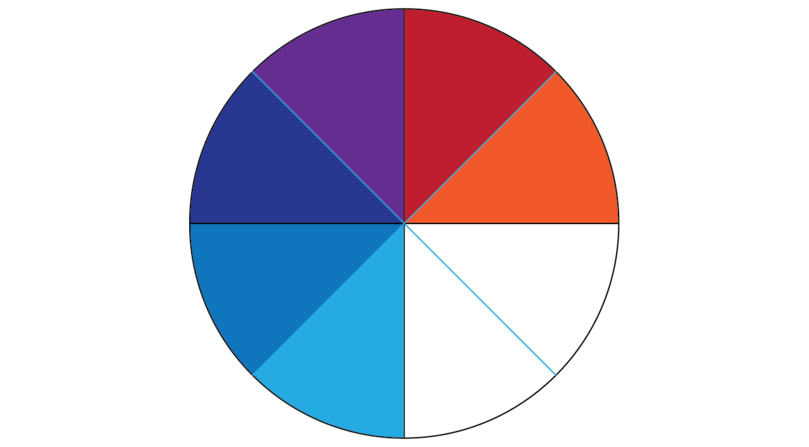
-
Step 4: Write down the answer.
There are six different colours. We can count every 18 six times. This means that 6 people can each take home 18 of the cake.
34÷18=6
Worked example 6.15: Using a reciprocal to divide: fraction ÷ fraction
Calculate:
34÷18
-
Step 1: Regard division as another form of multiplication.
Dividing by a fraction is the same as multiplying by the reciprocal of the fraction.
34×81 -
Step 2: Follow the short method for multiplying fractions with fractions.
34×81=3×84×1=244=6
Exercise 6.8: Divide fractions by fractions
Calculate each of the following.
-
37÷12
Multiply by the reciprocal of the second fraction.
37×21=3×27×1=67 -
1013÷34
Multiply by the reciprocal of the second fraction.
1013×43=10×413×3=4039=1139 -
1215÷35
Multiply by the reciprocal of the second fraction.
1215×53=12×515×3=6045=43=113
Multiplying and dividing mixed numbers
There are various methods that may be used to multiply and divide mixed numbers. It is recommended that you first convert all mixed numbers to improper fractions before you multiply or divide.
If necessary, go back to Chapter 4 and revise how to convert mixed numbers to improper fractions.
Simplifying before multiplying
Improper fractions sometimes involve large numbers that are not so easy to multiply. To make things easier, you should try to simplify the numerators and denominators before you multiply them.
Note that the order in which we multiply numbers do not affect the answer. For example:
- 3×5=15 and 5×3=15
- 45×13=415 and 13×45=415
In Chapter 4 you learnt that equivalent factors have the same value. We find equivalent factors by multiplying or dividing the numerator and denominator by the same number. For example:
12÷216÷2=68 6÷28÷2=34Worked example 6.16: Dividing mixed numbers
Calculate:
258÷334
-
Step 1: Convert the mixed numbers to improper fractions.
258=(8×2)+58=218 334=(4×3)+34=154 -
Step 2: Regard division as another form of multiplication.
Dividing by a fraction is the same as multiplying by the reciprocal of the fraction.
218×415 -
Step 3: Write down the first step for multiplying fractions by fractions. Then see whether there are numerator and denominator pairs that have common factors.
The first step is:
21×48×15The HCF of 4 and 8 is 4.
The HCF of 21 and 15 is 3.If necessary, go back to Chapter 2 to revise how to find the highest common factor (HCF) of two or more numbers.
Write the pairs underneath each other. Remember, we may multiply numbers in any order.
4×218×15 -
Step 4: Divide by the common factors you identified in Step 3.
We may find equivalent fractions by dividing a numerator and denominator by the same number.
4÷4×21÷38÷4×15÷3 -
Step 5: Write down the simplified expression and calculate the answer.
1×72×5=710 -
Step 6: Check that the answer is in its simplest form. Write improper fractions as mixed numbers.
In this case, the answer is in its simplest from.
If necessary, go back to Chapter 4 and revise how to convert improper fractions to mixed numbers.
Exercise 6.9: Multiply and divide mixed numbers
Calculate the following.
-
513×234
513=(3×5)+13=163 234=(4×2)+34=114 163×114=16×113×4
The HCF of 16 and 4 is 4.
(16÷4)×11(4÷4)×3=4×111×3=443=1423 -
335×169
335=(5×3)+35=185 169=(9×1)+69=159 185×159=18×155×9
The HCF of 18 and 9 is 9.
(18÷9)×(15÷5)(9÷9)×(5÷5)=2×31×1=61=6
The HCF of 15 and 5 is 5. -
718÷434
718=(8×7)+18=578 434=(4×4)+34=194 578÷194=578×419=57×48×19
The HCF of 4 and 8 is 4.
(57÷19)×(4÷4)(19÷19)×(8÷4)=3×11×2=32=112
The HCF of 57 and 19 is 19. -
416÷389
416=(6×4)+16=256 389=(9×3)+89=359 256÷359=256×935=25×96×35
The HCF of 6 and 9 is 3.
(25÷5)×(9÷3)(35÷5)×(6÷3)=5×37×2=1514=1114
The HCF of 35 and 25 is 5. -
6310÷145
6310=(10×6)+310=6310 145=(5×1)+45=95 6310÷95=6310×59=63×510×9
The HCF of 5 and 10 is 5.
(63÷9)×(5÷5)(9÷9)×(10÷5)=7×11×2=72=312
The HCF of 63 and 9 is 9.
6.3 Practical applications
You can use your knowledge of fractions to solve problems. Here are some hints:
- Remember that the denominator of a fraction tells us how many parts a whole is divided into. The numerator tells us how many of those parts we are dealing with.
- Read the problem carefully. If at all possible, draw a diagram to represent the situation.
- Percentages are fractions. For example, 70% of 25 may be written as 70100×25.
- A whole, for example all the sweets or the full length of time or all the money, is represented by the number 1.
- Decide whether you must add, subtract, multiply or divide:
- "find the sum" means you must add
- "find the difference" means you must subtract
- "of" means you must multiply
- "share between" means you must divide
Exercise 6.10: Use operations with fractions to solve problems
-
Chijindum spends 14 of his pocket money on clothes and 310 on sweets. What fraction of his pocket money did he spend altogether?
0014+310=520+620=5+620=1120
Chijindum spends 1120 of his pocket money altogether.
-
It takes Adanna 58Â of an hour to walk to school. How long will it take her to walk to school, back home and back to school again?
0058×3=5×38=158=178 hours
It will take Adanna 178Â hours.
-
In a certain class, 58 of the class are girls and 910 of the girls take Mathematics. Calculate the fraction of the class that are girls and take Mathematics.
910×58=9×510×8=4580=916
916 of the class are girls and take Mathematics.
-
Only 910 of the Mathematics class came to school on Friday. At the start of the lesson, the principal called 16 of the class to his office. What fraction of the class had Mathematics on Friday?
00910−16=2730−530=27−530=2230=1115
1115 of the class had Mathematics on Friday.
-
Talatu decides to share a packet of sweets with her siblings. She gives 14 of the packet to her sister and 38 to her brother. What fraction of the sweets does she keep for herself?
001−14−38=88−28−38=8−2−38=38
Talatu kept 38 of the sweets for herself.
-
A local store owner buys rice in bags of 50Â kg. He then makes up smaller bags to sell. If a small bag is 615Â kg, how many small bags can he make up from one large bag?
0050÷615=50×156=50×156=7506=125
The store owner can make up 125 small bags from one large bag.
-
There is 1416Â litre of vegetable oil left in a bottle. A baker must measure this out in cups of 14Â litre each. How many cups will she measure out?
1416÷14=1416×41=14×416×1=5616=72=312
The baker can measure out cups.
-
Habib goes home after school. He spends a  hour having lunch, then watches television for  hours, and then does his homework for  hours. How long did all these activities take?
These activities take hours.
-
A clothing store offers a discount of 15% on a pair of shoes that originally cost ₦1,500. Calculate the new, discount price.
The new, discount price is ₦1,500-₦225=₦1,275.
-
A bag of garri has a mass of  kg. How many small packets, each with a mass of  kg, can be made up from the bag?
small packets can be made up.
6.6 Summary
- To add or subtract fractions with the same denominator:
- Write down the denominator.
- Then add or subtract the numerators.
- To add or subtract fractions with different denominators:
- Find the LCD.
- Find equivalent fractions with the LCD as denominator.
- Then add or subtract the numerators.
- To multiply fractions and whole numbers:
- Write down the denominator of the fraction.
- Multiply the numerator of the fraction by the whole number.
- To multiply fractions with fractions:
- Multiply the numerators.
- Multiply the denominators.
- The reciprocal of a fraction is the "opposite" of the fraction, which we get by swapping the numerator and denominator. Whole numbers also have reciprocals. For example:
- The reciprocal of is .
- The reciprocal of 8 is .
- Dividing by a fraction or whole number is the same as multiplying by its reciprocal. For example:
- Before you add, subtract, multiply or divide mixed numbers, first convert them to improper fractions.
- When you have to multiply fractions with large numerators or denominators, simplify first.
